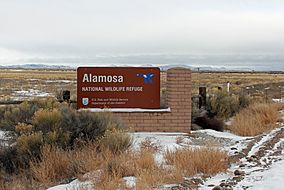Alamosa National Wildlife Refuge facts for kids
Quick facts for kids Alamosa National Wildlife Refuge |
|
|---|---|
|
IUCN Category IV (Habitat/Species Management Area)
|
|

The sign at the northern entrance in late 2014.
|
|
| Location | Alamosa County, Conejos County & Costilla County, Colorado, United States |
| Nearest city | Alamosa, CO |
| Area | 11,169 acres (45.20 km2) |
| Established | 1962 |
| Governing body | U.S. Fish and Wildlife Service |
| Website | Alamosa National Wildlife Refuge |
The Alamosa National Wildlife Refuge is a special protected area in southern Colorado, United States. It covers about 11,169 acres, which is like having over 8,400 football fields! This refuge was created in 1962 to be a safe home for many different kinds of birds and other wild animals.
It is located in the San Luis Valley, right next to the Rio Grande river. You can find it about 8 miles southeast of the town of Alamosa. The United States Fish and Wildlife Service takes care of this refuge. They also manage two other nearby refuges, the Baca and Monte Vista National Wildlife Refuges.
Discover Alamosa National Wildlife Refuge
This refuge is a mix of different natural areas. You'll find wet meadows, which are grassy areas that are often damp or flooded. There are also oxbows, which are U-shaped lakes or ponds formed when a river changes its path. Along the Rio Grande, there are riparian corridors, which are green areas with trees and plants right next to the river.
What Animals Live Here?
The Alamosa National Wildlife Refuge is home to many amazing creatures. You might spot various songbirds singing in the trees or different water birds near the ponds and river. Birds of prey, like hawks and eagles, soar high above looking for food.
Some of the mammals you could see include:
Visiting the Refuge
The refuge has a visitor center where you can learn more about the area and its wildlife. There's also a two-mile hiking trail that goes in a loop, perfect for exploring the beautiful scenery.
Water for the refuge comes from the Rio Grande river. Extra water is also brought in through something called the Closed Basin Project. This helps keep the wetlands healthy for all the animals. The Alamosa refuge is known for being a bit wilder and less managed than some other refuges nearby.


